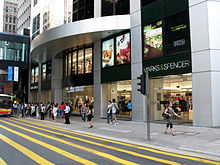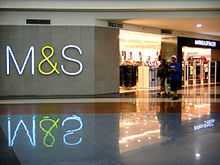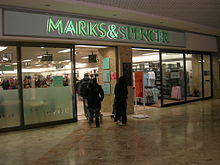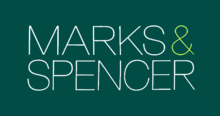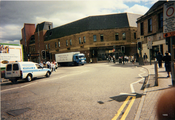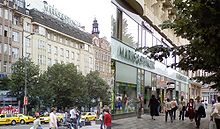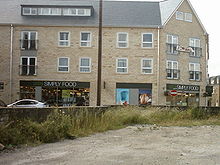
Marks & Spencer
Background to the schools Wikipedia
This wikipedia selection has been chosen by volunteers helping SOS Children from Wikipedia for this Wikipedia Selection for schools. SOS Children is the world's largest charity giving orphaned and abandoned children the chance of family life.
 |
|
| Type | Public limited company |
|---|---|
| Traded as | LSE: MKS OTCQX: MAKSY |
| Industry | Retailing |
| Founded | Leeds, West Yorkshire, England (1884) |
| Founder(s) | Sir Michael Marks Thomas Spencer |
| Headquarters | City of Westminster, London, England |
| Number of locations | 1,010 stores (2010) |
| Area served | Worldwide |
| Key people | Marc Bolland (CEO) Robert Swannell (Chairman) |
| Revenue | £9.934.3 billion (2012) |
| Operating income | £746.5 million (2012) |
| Profit | £489.6 million (2012) |
| Employees | 81,223 (2012) |
| Website | marksandspencer.com |
Marks and Spencer plc (also known as M&S; colloquially known as Marks and Sparks, Marks's or, simply, Marks) is a major British retailer headquartered in the City of Westminster, London, with 703 stores in the United Kingdom and 361 stores spread across more than 40 countries. It specialises in the selling of clothing and luxury food products. M&S was founded in 1884 by Michael Marks and Thomas Spencer in Leeds.
In 1998, it became the first British retailer to make a pre-tax profit of over £1 billion, though a few years later it plunged into a crisis which lasted for several years. In November 2009, it was announced that Marc Bolland, formerly of Morrisons, would take over as chief executive from executive chairman Stuart Rose in early 2010; Rose remained in the role of non-executive chairman until he was replaced by Robert Swannell in January 2011.
It is listed on the London Stock Exchange and is a constituent of the FTSE 100 Index.
History
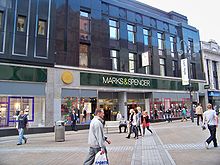
The company was founded by a partnership between Michael Marks, a Polish Jew from Slonim, Poland (now in Belarus), and Thomas Spencer, a cashier from Yorkshire. On his arrival in England, Marks worked for a company in Leeds, called Barran, which employed refugees (see Sir John Barran, 1st Baronet). In 1884 he met Isaac Jowitt Dewhirst whilst looking for work. Dewhirst lent Marks £5 which he used to establish his Penny Bazaar on Kirkgate Market, in Leeds. Dewhirst also taught him a little English. Dewhirst's cashier was Tom Spencer, an excellent book-keeper; he acquired a lively and intelligent second wife, Agnes, who helped improve Marks's English. In 1894, when Marks acquired a permanent stall in Leeds' coveted market, he invited Spencer to become his partner.
The next few years saw Michael Marks and Tom Spencer open market stalls in many locations around the North West of England and moved the original Leeds Penny Bazaar to 20, Cheetham Hill Road, Manchester.
Marks and Spencer, known colloquially as "Marks and Sparks", or "M&S", made its reputation in the early 20th century on a policy of only selling British-made goods (a policy discontinued in 2002). It entered into long term relationships with British manufacturers, and sold clothes and food under the " St Michael" brand, that was introduced 1928. The St Michael honours Michael Marks. It also accepted the return of unwanted items, giving a full cash refund if the receipt was shown, no matter how long ago the product was purchased, which was unusual for the time. It adopted a 90-day returns policy in 2005 and on 12 April 2009 the refund policy changed once again to 35 days.
M&S staff raised £5,000 to pay for a Spitfire fighter called The Marksman in 1941.
By 1950, virtually all goods were sold under the "St Michael" label. M&S lingerie, women's clothes and girls' school uniform were branded under the "St Margaret" label until the whole range of general merchandise became St Michael. Simon Marks, son of Michael Marks, died in 1964, after fifty-six years' service. Israel Sieff took over as chairman and in 1968, John Salisse became the company Director. A cautious international expansion began with the introduction of Asian food in 1974. M&S opened stores in continental Europe in 1975 and in Ireland four years later.
The company put its main emphasis on quality, including a 1957 stocking size measuring system. For most of its history it also had a reputation for offering fair value for money. When this reputation began to waver, it encountered serious difficulties. Arguably, M&S has historically been an iconic retailer of 'British Quality Goods'.
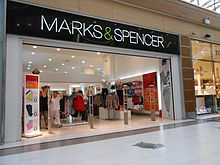
The uncompromising attitude towards customer relations was summarised by the 1953 slogan: "The customer is always and completely right!".
Energy efficiency was improved by the addition of thermostatically controlled refrigerators in 1963.
M&S has sold Christmas cakes and Christmas puddings since 1958. In an effort to improve the quality of their Swiss rolls, they hired the food expert Nat Goldberg, who made a major improvement across their entire cake range, which had lost the public's favour a few years earlier. As a later measure to improve food quality food labelling was improved and "sell by dates" were phased in between 1970 and 1972.
Smoking was banned from all M&S shops in 1959 because of the fire hazards it posed. It later became a permanent rule after concerns were raised by asthmatics about their health.
All international shops are operated under franchise, with the exception of those in the Republic of Ireland and Hong Kong which remain in company ownership.
The first M&S shop in central Asia was built in Kabul Afghanistan in the 1960s but was later shut down, due to political unrest of Soviet Russia.
M&S expanded into Canada in 1973, and at one point had forty seven stores across Canada. Despite various efforts to improve its image, the chain was never able to move beyond its reputation there as a stodgy retailer, one that catered primarily to senior citizens and expatriate Britons. The shops in Canada were smaller than British outlets, and did not carry the same selection. In the late 1990s, further efforts were made to modernise them and also expand the customer base. Unprofitable locations were closed. Nonetheless, the Canadian operations continued to lose money, and the last 38 shops in Canada were closed in 1999.
Expansion into France began with shops opening in Paris at Boulevard Haussmann and Lyon in 1975, followed by a second Paris shop at Rosny 2 in 1977. Further expansion into other French and Belgian cities followed into the 1980s. Although the Paris shops remained popular and profitable, the whole of the Western European operation did not fare as well and eighteen shops were sold in 2001. However in April 2011, M&S has changed directions again with an announcement to reopen a store that will not only sell clothing but food as well. In addition the group will also open several food outlets throughout the French capital. The first branch opened on 24 November 2011 at the Champs-Élysées in a ceremony attended by company CEO Marc Bolland, model Rosie Huntington-Whiteley and British Ambassador to France, Sir Peter Westmacott. The Daily Mail reported that 1,000 customers queued outside for over 2 hours at the opening of the 1,400 sq metre store.
In 1988, the company acquired Brooks Brothers, an American clothing company and Kings Super Markets, a US food chain. They were subsequently sold off, in 2001 and 2006 respectively.
M&S's profits peaked in financial year 1997/1998. At the time it was seen as a continuing success story, but with hindsight it is considered that during Sir Richard Greenbury's tenure as head of the company, profit margins were pushed to untenable levels, and the loyalty of its customers was seriously eroded. The rising cost of using British suppliers was also a burden, as rival retailers increasingly imported their goods from low-cost countries, but M&S's belated switch to overseas suppliers undermined a core part of its appeal to the public. Another factor was the company's refusal until 2001 to accept any credit cards except its own chargecard.
These factors combined to plunge M&S into a sudden slump, which took the company, its shareholders, who included hundreds of thousands of small investors, and nearly all retail analysts and business journalists, by surprise. The company's share price fell by more than two thirds, and its profits fell from more than a billion pounds in 1997 and 1998 to £145 million in the year ended 31 March 2001.
Marks & Spencer launched an online shopping service in 1999.
In 2001, with changes in its business focus such as accepting credit cards, the introduction of the "Per Una" clothing range designed by George Davies, accompanied by a redesign of its underlying business model, profits recovered somewhat and M&S recovered some of its market share, but it was soon evident that problems remained.
In 2004, M&S was in the throes of an attempted takeover by Arcadia Group & BHS boss, Philip Green. On 12 July a recovery plan was announced which would involve selling off the financial services business to HSBC Bank plc, buying control of the Per Una range, closing the Gateshead Lifestore and stopping the expansion of its Simply Food line of shops. Philip Green withdrew his takeover bid after failing to get sufficient backing from shareholders.
In February 2007, M&S announced the opening of the world's largest M&S shop outside the UK at Dubai Festival City.
On 2 October 2008, M&S opened its first mainland China shop in Shanghai. Problems with the supply chain for the first few months of opening led Stuart Rose, M&S chairman, to describe failures in "basic shopkeeping".
Financial performance
M&S is listed on the London Stock Exchange and is a constituent of the FTSE 100 Index.
After fostering significant growth in recent years, mid-2008 saw share prices plunge to well under half their value of twelve months before, as M&S struggled to cope with more conservative shoppers in the credit crunch.
Until 1999 M&S's financial year ended on 31 March. Since then, the company has changed to reporting for 52 or 53-week periods, ending on variable dates.
| Year ended | Turnover (£ M) | Profit before tax (£ M) | Net profit (£ M) | Basic eps (p) |
|---|---|---|---|---|
| 31 March 2012 | 9,934.3 | 658.0 | 489.6 | 32.5 |
| 2 April 2011 | 9,740.3 | 780.6 | 598.6 | 38.8 |
| 3 April 2010 | 9,536.6 | 702.7 | 523.0 | 33.5 |
| 28 March 2009 | 9,062.1 | 706.2 | 506.8 | 32.3 |
| 29 March 2008 | 9,022.0 | 1,129.1 | 821.0 | 49.2 |
| 31 March 2007 | 8,588.1 | 936.7 | 659.9 | 39.1 |
| 1 April 2006 | 7,797.7 | 745.7 | 520.6 | 36.4 |
| 2 April 2005 | 7,490.5 | 505.1 | 355.0 | 29.1 |
| 3 April 2004 | 8,301.5 | 781.6 | 452.3 | 24.2 |
| 29 March 2003 | 8,019.1 | 677.5 | 480.5 | 20.7 |
| 30 March 2002 | 8,135.4 | 335.9 | 153.0 | 5.4 |
| 31 March 2001 | 8,075.7 | 145.5 | 2.8 | 0.0 |
| 1 April 2000 | 8,195.5 | 417.5 | 258.7 | 9.0 |
| 31 March 1999 | 8,224.0 | 546.1 | 372.1 | 13.0 |
| 31 March 1998 | 8,243.3 | 1,155.0 | 815.9 | 28.6 |
| 31 March 1997 | 7,841.9 | 1,129.1 | 746.6 | 26.7 |
| 31 March 1996 | 7,233.7 | 965.8 | 652.6 | 455.8 |
Social and environmental policy
Look Behind the Label
In 2006, the Look Behind the Label marketing campaign was introduced. The aim of this campaign was to highlight to customers the various ethical and environmentally friendly aspects of the production and sourcing methods engaged in by M&S including: Fairtrade products, sustainable fishing and environmentally friendly textile dyes. All coffee and tea sold in M&S stores is now Fairtrade. In addition, the company offers clothing lines made from Fairtrade Cotton in selected departments.
At Christmas, the company introduces a range of food products to support the housing charity Shelter, predominantly in the food-to-go line including a range of seasonal Christmas sandwiches.
Plan A

On 15 January 2007, M&S launched an initiative, known as "Plan A", to dramatically increase the environmental sustainability of the business within 5 years and expected to cost £200 million.
The plan covers "100 commitments over 5 years to address the key social and environmental challenges facing M&S today and in the future" with the tag-line "Because there is no Plan B". The commitments span five themes: climate change, waste, sustainable raw materials, 'fair partnership' and health, with the aim that, by 2012, it will:
- Become carbon neutral
- Send no waste to landfill
- Extend sustainable sourcing
- Help improve the lives of people in their supply chain
- Help customers and employees live a healthier life-style
Despite an 18% fall in the share price in January 2008, following publication of their latest trading statement, the company confirmed that they would be continuing with the plan, saying that there were 'compelling commercial — as well as moral — reasons to do so'.
The now iconic brown, reusable, hessian bag was first introduced in 2007 as an early part of this plan. It is hoped that this will reduce the use of plastic carrier bags over the next few years.
May 2008 saw the introduction of the 5p carrier bag scheme at M&S stores, with customers now paying 5p per standard sized vest carrier bag for food purchases. This implementation was brought about through the Plan A scheme, to try to discourage use of the traditional plastic bag. All profits from the sale of food bags used to go to Groundwork UK. In June 2011, M&S launched the Forever Fish campaign to promote the protection of Marine Wildlife in the UK. As of the end of June 2011, all profits from the sale of food bags now go to this charity.
In becoming carbon neutral the company has committed to only use carbon offsetting as a last resort, restricted to cases "where it is required by government or where the technology for green air or road transport will not be available for the foreseeable future".
As of August 2008, M&S had three wind turbines in operation, one at Methlick and two near Strichen, generating enough power to supply three stores via the National Grid. In April 2009 the company began purchasing 2.6 TWh of renewable energy (wind and hydroelectric) from Npower, enough to power all Marks & Spencer stores and offices in England and Wales.
Company chairman Sir Stuart Rose is personally committed to further promoting green issues and the recycling of plastic bottles. He has also pledged to reduce non-glass wastage by 25% and plastic carrier bag usage by 33% in the near future.
Charity work
M&S has sold a wide range of charitable women's clothes for Breakthrough Breast Cancer for many years and the Ashbourne store collected a total of £2,000 for a local Derbyshire hospital's new ECG machine in 2010.
Controversy
Support for Israel
Marks & Spencer has been criticised by pro-Palestinian and left wing groups over its past support for Zionism and for fruit trading with the state of Israel, a cause which it had promoted since its inception. For instance, prior to Israel's creation, various senior figures in the company advocated Zionist ideas, with Israel Sieff, the group’s chairman, advocating mass deportation in 1941 by stating that in order to found a Zionist state, "large sections of the Arab population of Palestine should be transplanted to Iraq and other Middle Eastern states." This moral support continued until the 1980s. On the other hand however, in his 1990 memoir, M&S' former chairman, Marcus Sieff (who was chairman from 1974 until 1984), wrote, "Another example of the demand for quality and value has been the development over the past twelve years of the firm Delta, which was established in Carmiel, in northern Galilee in Israel, thirteen years ago by a remarkable industrial leader, Dov Lautman. The plant initially manufactured men’s briefs, and Mr Lautman wished to export to Marks & Spencer. Although it has been Marks & Spencer's policy to encourage economic development in Israel, it was on the basis that a product of similar value and quality could not be found in the United Kingdom...Of Dov Lautman’s three thousand employees about one thousand one hundred are Jewish, one thousand Israeli Arabs and the rest Druse. He treats all his employees equally and in this expanding business there is much scope for promotion. He has made it a rule that promotion goes to whoever is the most suitable for it, Arab, Jew or Druse. During the sixteen months in which the Arab uprisings in Gaza and the West Bank have taken place up to the time of writing, no Israeli Arab working at Delta has been absent from work on that account."
In the past, Marks & Spencer's perceived moral support for Israel led to various pressure groups calling for boycotts of M&S goods, and demonstrations to be held outside of M&S shops. In one case, a Brighton based shop was vandalised with pro-Palestinian and anti-Zionist graffiti.
The company states that 'We deal with politicians and officials, in government and opposition. We do not support or align ourselves to political parties and make no political donations '.
Cut flowers
War on Want criticised M&S, along with Tesco and Sainsbury's, in its Growing Pains report for using its influence to squeeze overseas suppliers to constantly reduce their costs while boosting their own profits.
Comprehensive Spending Review
In October 2010, Chairman Sir Stuart Rose was a signatory to a controversial letter to The Daily Telegraph which claimed that "The private sector should be more than capable of generating additional jobs to replace those lost in the public sector, and the redeployment of people to more productive activities will improve economic performance, so generating more employment opportunities", despite recent job cuts of 1,000 staff. This prompted calls for a boycott of Marks & Spencer, as well as the companies represented by the other signatories to the letter.
Marketing
Change of historic logo
During the height of the company's troubles at the beginning of the 21st century, the St Michael brand used as the selling label for all M&S products was discontinued in favour of Marks & Spencer and a new logo in the Optima typeface was introduced and began to appear in place of St Michael on product packaging. The same logo was also rolled out across store fascias and carrier bags. The St Michael name was subsequently adopted as a 'quality guarantee' and appeared as the St Michael Quality Promise on the back of food products, on the side of delivery vehicles and on in-store ordering receipts. This has since been phased out, although receipts for made-to-order furniture still feature this 'seal of approval' on the bottom.
Your M&S
When Steve Sharp joined as marketing director in 2004, after being hired by new Chief Executive Sir Stuart Rose, he introduced a new promotional brand under the Your M&S banner, with a corresponding logo. This has now become the company's main brand in its advertising, online presence and in-store merchandising. The clean fonts and modern colours of the new image are somewhat incongruous alongside the traditional M&S signage and associated fittings that still adorn many of the unmodernised 'core' stores themselves. The only thing in common with the former design is the use of M&S traditional green in the ampersand of the new logo. In 2007, the same typeface used for the new M&S logo was adopted to replace the Optima logo used on product packaging and store fascias since 2000. This new logo is also beginning to appear on new-style sewn in clothing labels and presented in its linear, non-stacked form, complete with lime-green ampersand.
New store format
A new store format designed by Urban Salon Architects has won much praise and is in the process of being rolled out across all stores, with a majority of stores being completed by the end of 2008.
Brighter look
The full new look makeover is a reworking of store design, including the gutting of old stores, and installation of a brighter, more spacious, modern and contemporary design, replacing carpets and laminate floors with white tile throughout (black tile in Foods, apart from in the Leamington high street and Merry Hill store) thus opening the floor instead of having pathways, having new contemporary white mannequins in new designs and poses, new displays and kit such as new design clothing rails, avant garde product stands (formerly known as "Lutons"), display and product walls, window display styles, larger fitting rooms, glass walls, till points, and general total updating of decals, signage, equipment (including smaller CCTV dome cameras), and lighting.
Several of the old 'Luton' format stores have received what is known internally as a 'Light Touch' re-fit, which involves bringing the store up-to-date with new floors, till points, mannequins and signage (the actual work differs per store) but not to the extent of a full refurbishment, as mentioned above. This occurs in stores that are subject to re-development or re-location.
Self check-outs
M&S introduced self check-out tills in the food-halls of a small number of trial stores in 2002. Self check-out was implemented in the general merchandise sections in three trial stores in 2006 and roll-out to flagship stores is in progress.
Product line history
St Michael was a brand that was owned and used by Marks & Spencer from 1928 until 2000.
The brand was introduced by Simon Marks in 1928, after his father and co-founder of Marks & Spencer, Michael Marks. By 1950, virtually all goods were sold under the St Michael brand. M&S lingerie, women's clothing and girls' uniform were branded under the St Margaret brand, until the whole range of general merchandise became St Michael.
Marks & Spencer were selling clothes under the St Margaret and St Michael label by the mid-1950s and launched their school uniforms in the early 1950s. The synthetic fibre Tricell was first used in 1957 and lasted until the 1970s. and another synthetic fibre called Coutelle was first launched, nationally, by Marks & Spencer during 1960 and also lasted well in to the 1970s. Machine washable wool first appeared in 1972 and Lycra hosiery first came in during 1986.
M&S launched their own brands of domestic products, such as washing powder and aluminium foil in 1972, under the brand name of 'House-care'.
In 2000, Marks & Spencer dropped the St Michael brand, and replacing it with the Marks & Spencer brand. The St Michael name was subsequently adopted as a 'quality guarantee' and appeared as the St Michael Quality Promise on the back of food products, on the side of delivery vehicles and on in-store ordering receipts. The St Michael Quality Promise was phased out a few years ago.
In 2000, as part of the corporate modernisation plan, brands such as Autograph were launched.
M&S's relatively successful interior design 'Home' brand was launched in 2005 and featured products like vases, furniture and beds.
Boil-in-the-bag and sachet meals were first pioneered by M&S in 1972 and the award winning Gastropub food range was launched in 2004. The 'Melting middle chocolate pudding' campaign of 2005 has led to a remarkable 3,000% rise in chocolate pudding sales, something that has not recurred since. The Percy Pigs sweets were first created in 1995 and the billionth " Percy Pig" sweet was sold by the October 2007.
Per Una
Per Una was launched on 28 September 2001 as a joint venture between M&S and Next founder George Davies with the contribution of Julie Strang.
The Per Una brand has been a major success for the company, and in October 2004, M&S bought the brand in a £125 million, two-year service contract with George Davies. Mr Davies was to stay on for at least two years to run the company, with 12 months notice required if he wished to leave.
The teenagers' line called Per Una Due was launched in early 2004, but sales were poor and it was discontinued in the May 2004, whilst the adult lines had flourished by 2010.
Current M & S product lines
- Womenswear
- Personal (women's) fit
- Summer classics
- Classic collection
- Seasonal classics
- Beachwear
- Sportswear
- The Indigo collection
- Portfolio
- Per Una
- Autograph
- Autograph Weekend
- Buy me now or lose me for ever- limited editions: their discounted product line.
- Breakthrough Breast Cancer: M&S markets charitable clothes for Breakthrough Breast Cancer.
- Lingerie and hosiery
- Shoes
- Childrenswear
- Paul Hervey-Brookes Gardening Gifts. A range of gifts for gardeners designed by English garden designer Paul Hervey-Brookes
- Babywear
- Percy Pig and Colin Caterpillar sweets
- Menswear
- Perfect seasonal clothes
- Cosmetics and Perfumes
- Homeware
- Technology
- Food and drink
- Gastropub' are ready meals inspired by pub cuisine for home cooking It got a 'Golden pub-meal commendation' in 2005. 'Food to go' was a grab bag or packed lunch ready cooked meal that enveloped out of the popular food range in early 2010.
- Alcohol: M&S has an extensive wine and beer range, which was first started in 1973. In 2006 and 2007, M&S entered over a hundred of its own wines into two wine competitions, The Decanter World Wine Awards and The International Wine Challenge. Both years, almost every wine won an award, ranging from the 2005 Secano Pinot Noir, Leyda Valley, Chile (Best Pinot Noir in the world for under £10) to the Rosada Cava (Commended).
- Gift shop/Christmas gift shop
- M&S Money – Marks and Spencer Financial Services
- M&S Energy – Electricity & Gas (in partnership with Scottish & Southern) and Home Insulation
- The company also began to sell other branded goods like Kellogg's Corn Flakes in November 2008. however, the business as of 2011 is reviewing its branded food offering (those lines which aren't M&S branded) due to comparatively poor uptake of these lines as well as potentially de-tracting from the newly introduced "Only at..." tagline. The business will begin winding down the branded offering with the aim of only offering customers branded lines which it doesn't currently have an M&S brand alternative to.
- Plus Fit- Was launched in selected stores during July 2010 for overweight children to wear. It has proven to be a popular line.
- The children’s (online only) ‘Living the Dream’ range of Lewis Hamilton & Heikki Kovalainen memorabilia and merchandise was launched in September 2009. Merchandise also relating to fellow racing driver Jenson Button was added to the range during April 2010.
Online services
Products could be ordered online since the mid-2000s, in response to some like Tesco launching their pioneering Tesco.com home shopping delivery service in the early 2000s. Both Tesco, M&S and others are expanding rapidly in to this new niche market.
M&S TV is an online TV station to advertise goods.
The online flower service was accused of unfair trading and using Google to piggy-back advertise on online searches aimed at Interflora online in 2010.
The John Lewis shopping chain beat M&S to the title of the UK's best high-street website by late 2010.
Brands
Old labels
The 'St Margaret', 'St Michael' and 'Homecare' brands were the time-honoured brand labels that fell out of use in the company-wide re-branding campaign of the early 2000s. The stylish 1996–1997 'Orient Express Tagged' brand was the first of numerous new brands, most of which were in feminine and children's clothes. The 'Orient Express Tagged' brand was part of the inspiration behind the 'Portfolio' brand. The men's Autograph brand was then launched in 2000 and continues to this day.
Sir Stuart Rose axed the ailing casual menswear brand SP Clothing, the View From sportswear range, the David Beckham children's range, DB07 clothes, the teenage range Per Una Due and several food lines in 2004, because he thought the business’ stock inventory management had become 'too complicated',.
The retailer had launched several brands, sub-brands and lines of women's wear and children's wear in recent years such as Indigo Collection Junior, Indigo Collection and Portfolio. Indigo Collection aimed at women over 30s, while Portfolio 45s. Overall, M &S has 10 women's wear sub-brands and sub-sub-brands, such as Per Una and Autograph, but only six menswear brands, such as Blue Harbour, North Coast and Collezione by 2010.
2008-9 restructuring plan
As part of the 2008-9 restructuring plan, 9 sub-brands that were deemed to be unprofitable, unnecessary or superfluous were either discontinued, merged or relaunched in 2008, with further activity, including some store closures, occurred in both 2009 and 2010.
| Line, sub-brand or brand involved. | Date of action. | Fate of line, sub-brand or brand involved. | Source(s). |
|---|---|---|---|
| Floor 1 discount brands—women's discount fashion clothes | Early 2008/the festive season of 2008–2009 | Replaced by the 'Designer discount' line in early 2008. It was relaunched in the festive season 2008–2009 as- By me now or lose me for ever- limited editions. | |
| Romper-suit republic—baby clothes (was only available online) | 2008 | Discontinued | . |
| The Shirt-sleeve empire—boys' shirts (was only available online) | 2008 | Discontinued | . |
| Essential—up market skirts and t-shirts | 2009 | Merged in to Portfolio, along with Perfect. 'Essential' now also continues as a seasonal line of the 'Autograph' brand. | . |
| Perfect—upmarket trousers, skirts and blouses | 2009 | Merged in to Portfolio, along with Essential. Perfect still operates in men's rain coats and cookware. 'Perfect' was relaunched in January 2010 as a seasonal sub-brand of 'Portfolio'. | |
| Plus range maternity (large stores only). | 2008 | Merged with Limited Collection Maternity as 'M&S Maternity'. | . |
| Limited Collection Maternity | 2008 | Merged with Plus Range Maternity as 'M&S Maternity' to simplify administration. | , |
| The Zandra Rhodes collection was a upmarket woollen clothes and t-shirts modelled and made by the British fashion designer Zandra Rhodes, CBE/ RDI | February 2010 | It was launched in April 2009, but was let gradually run down in the festive season during December 2009 and January 2010. It was finally discontinued due to poor sales performance in February 2010. | ,. |
| 'Party, Party, Party!' was a line of seasonal party clothes | July/October 2010. | Discontinued in July 2010, but then relaunched as 'Partyware' October 2010. | |
| 'Katy Livingston' was an up market sports clothes and merchandise relating to the British athlete Katy Livingston. | Mid 2010 | It was launched in early 2009 and developed in to the 'Performance' brand. 'Performance' was the resulting line of serious sportswear for dedicated female athletes that would merge with the feminine 'Sportswere' line in mid 2010 due to the need for administrative simplification. | |
| 'Frenchay' (was only available online)- French made, utilitarian/good value plastic home ware, clothes pegs, clothes hangers, etc. | The Festive season of 2008–2009. | It was merged in to the other 'Kitchens' brands. | |
| 'Fashion line'- babies' fashion clothes | Early 2010 | It merged with Babyware and Petite Babe. | . |
| 'Ready to play' playwear | Early 2010 | Discontinued, but some designs continued under the 'Casual line' | . |
| 'Themed collection'- Cartoon and story book character merchandised clothing | late 2008 | Merged with Character shop | . |
| 'Nightware'- Teen's night clothes | Early 2010 | Merged with the 'Sleepware' line | . |
| B.C.A.M.- charitable merchandise aimed at raising awareness of breast cancer. | The Festive season of 2009–2010. | Merged with B.C.A.UK as 'Love Pink'. | . |
| B.C.A.UK- on line charitable T-shirts for the under 40s. | The Festive season of 2009–2010. | Merged with B.C.A.M. as 'Love Pink'. | . |
| 'Food to go' line | The Festive season of 2010–2011. | It was merged in to ’Lunchtogo’ during the festive season of 2010–2011 | . |
- 'Conde Nast' (the M&S clothes, not Condé Nast Publications) -designer clothes were a planned sub-brand that was not launched in over the festive season of 2009–2010 because of the credit crunch and became part of the 'Indigo Collection' and 'Portfolio' lines.
- All the Kid’s furniture (the 'Kid's bedroom' line), bedding and electronic toys (part of the 'Toy shop' brand) were re-grouped and expanded as the 'Kids at home' brand in January 2010, but the merger had been repealed and broke back up by July 2010.
- Perfection (Autograph's & Per Una's perfumaries merged into one in early 2009)
- The company also began to sell branded goods like Kellogg's Corn Flakes in November 2008. It may discontinue branded goods in 2011 following a review by the new Chief Executive Marc Bolland.
2010 product audit
Another review and rebranding exercise was planned for late 2010 and 2011 after several years of declining sales in the womenswear department as born out by an audit conducted by the firm the Retail Knowledge Bank in August 2010.
2011 brand cull
Marc Bolland had considered axing several brands in early 2011 after an audit by the Retail Knowledge Bank in August 2010 revealed that sales of M&S womenswear were at a 10-year low. The audit covered both the Limited Collection, Autograph, Autograph Weekend, Classic Collection, Per Una, Portfolio and Indigo.
In mid-2010, Draper magazine claimed that Per Una was the only clothing brand that was not at risk of being axed in Mr Bolland's shake-up of the plethora of clothing brands sold at M&S. Per Una was planned to stay due to its successful and distinctive flair, but Portfolio and Indigo were planned go due to poor sales. Both the Limited Collection, Autograph, Autograph Weekend, Classic Collection brands were being considered for the cull during mid-2010, but were later given a reprieve.
It was revealed in November 2010, that there would be a major 3-year UK store revamp, which would cost between £850,000,000 and £900,000,000 and a cull of what Bolland called ""the often confusing" store layouts and "indistinguishable brands".
M&S also announced it was planning to take Twiggy international some time during 2010–2011.
Store and depot locations
Planned 2010 store closures
Twenty-two unprofitable and minor food stores, such as the ones at Ripon and Balham, were closed in early 2009 as part of a cost cutting measure.
In August 2010, it was confirmed that the Grantham branch of M&S would close, along with two other Lincolnshire branches in Skegness and Scunthorpe, due to low sales in these older format stores. The closures were met with protests from the local communities and petitions were signed in support of retaining the stores. Despite these protests, the store closures will go ahead.
New stores opening It was revealed in November 2010, that new stores would be opening in China and India. One of the planned stores is scheduled to open in the Shanghai region in 2011.
2010 Plan
On 9 November 2010, chief executive Marc Bolland revealed plans to strengthen the company’s overall brand image and targeting sales of between £800m and £1bn for which company will increase capital expenditure to £850m to £900m over the next three years to fund the plans. As per the 2010 Plan company will stop its 'Portfolio' fashion brand, sales of electrical products and revamp its website. The company also announced a new marketing strapline – 'Only at M&S'.
May–August 2011 corporate revamp
Fashion guru Sara Bradley was reported in March as planning to take a 'senior role' within M&S's clothing business by mid 2011.
By 25 May 2011, Marc Bolland, had ordered a new store design that the company would spend a capital expenditure of about £600m between 2011 and 2014 on its UK stores.
The scheme will involve M&S launching a range of different store formats based on the age, affluence and demographics of people in the various areas from October, in what will be termed the "cluster" model internally. A new in-store "navigation scheme" will be launched after research showed that shoppers found M&S store layouts confusing and "difficult to shop [in]".
The chain was also forced to increase the amount of money-off promotions and deals that it offered due to the declining economic climate in the UK.
The firm's packaging, clothing brands and labels will change. The retailer has announced plans to abandon the "Marks & Spencer" label from its clothes, replacing it with "M&S Woman" and "M&S Man". It will also re-launch its Per Una and North Coast clothing sub-brands.
The official goal is to be better at food than supermarkets and better at clothes and general merchandise than department stores.
Marks & Spencer dropped a series of planned television adverts in the July 2011, featuring Twiggy, Dannii Minogue and VV Brown as it started its corporate image revamp.
Twiggy was expected to be appearing on billboards and in-store promotions for a while longer with the retailer.
Both Lisa Snowdon and Jamie Redknapp were still continuing to promote the Marks & Spencer brand in future.
Jerry Hall and Mick Jagger's daughter Lizzy, were reportedly removed from the corporate commercial series listings earlier that year.
Alison Jones, who is the daughter of Sir David Jones, joined M&S on 2 June, as the new brand director for general merchandise, under the leadership of marketing director, Steve Sharp. She had gained previous experience at Topshop and Debenhams. The role has been created to give a more cohesive approach to M&S's branding and help develop and co-ordinate the brand and strategy for M&S's clothing division.
Head office locations
London
The headquarters of M&S was for a hundred years at Michael House, 55 Baker Street, London. In 2004 the company moved to a new headquarters designed by mossessian & partners at Waterside House in the new Paddington Basin, London.
Across the UK
As well as the main offices in London, there are a number of other head office sites across the UK; Stockley Park (IT Services), Salford Quays and Spinningfields, Greater Manchester (Marks & Spencer Shared Services Ltd. which provides human resources, and finance administration), Chester (HSBC's M&S Money and Retail Customer Services), and Draycott (per una).
Overseas
The company has overseas sourcing offices in Hong Kong, Thailand, India, Bangladesh, Turkey, China, Italy, Indonesia and Sri Lanka.
Stores
UK and Ireland shops
M&S have over 703 shops throughout the United Kingdom, with nearly 1.2 million square metres (12.5 million square feet) of selling space. This includes the flagship, and largest, shop, Marble Arch, London, on Oxford Street, which has around 16,000 square metres (170,000 sq ft) of shop floor.
The second largest is in Warrington (Gemini), although the forthcoming M&S in Ellesmere Port will take over as the largest outside London. The third largest shop is at the Sprucefield Centre in Lisburn, Northern Ireland. In 1999 M&S opened its shop in Manchester's Exchange Square, which was destroyed in the 1996 Manchester bombing and rebuilt. At re-opening, it was the largest M&S shop with 250,000 sq ft (23,000 m2) of retail space, but half was subsequently sold to Selfridges, the company's second site in Manchester.
M&S has opened a number of stores at out of town locations since the trend to build shopping centres away from town centres became popular in the 1980s. The first was at the MetroCentre, Gateshead, Tyne and Wear, which opened in 1986. Another notable example is the store at the Merry Hill Shopping Centre at Brierley Hill, West Midlands. This store opened on 23 October 1990 shortly after the closure of stores in the nearby town centres of Dudley and West Bromwich; the Merry Hill store was not originally intended to be replace these two town centres store, but both the Dudley and West Bromwich stores had experienced a downturn in trade as the opening of the Merry Hill store loomed, and both stores were closed on 25 August 1990.
At the beginning of 2011, M&S closed three shops in Lincolnshire. Despite much protesting and local media coverage the three stores in Grantham, Skegness and Scunthorpe were all closed, Marks & Spencer citing poor sales. All three towns have now lost their main high-street retailer and concerns have been raised about the viability of the shopping centres now that M&S have deserted them.
Before Christmas 2006, twenty-two M&S shops were open for 24-hour trading including the recently opened new retail park stores at Bolton Middlebrook and at the Abbey Centre, Newtownabbey, Northern Ireland.
M&S have over 20 shops including three Simply Food outlets throughout Ireland. M&S opened its first shop in the Republic on Mary Street, Dublin in 1979 (now part of the Jervis Shopping Centre). A shop in Grafton Street, followed in 1988, Cork in 1989, then in 1996 the Grafton Street location to its present location in the former Brown Thomas store and finally the first out-of-town shop in Liffey Valley in October 1998. The new Grafton Street shop now boasts M&S's only 'The Restaurant' offering outside of the UK.
The newest Irish outlet in Douglas opened on 25 November 2010 at Douglas Village Shopping Centre, Cork. The Douglas shop is a fairly small outlet devoting some space to the M&S clothing range, and a food hall. The store was badly damaged by floods in Douglas during June 2012 and closed for extensive repairs. The Irish stores use a similar format and product line to the UK stores, including use of the M&S logo (which at Liffey Valley is the only logo used on exterior signs since a June 2007 refit and since opening in Killarney).
The company is committed to the expansion of its Irish operations with a number of new shops opened in 2009 including Clonmel (opened 25 June 2009), Navan, and Limerick which is one of the largest in Ireland at 110,000 square feet (10,000 m2) but will be overtaken shortly after by a new store in Swords, County Dublin at 130,000 square feet (12,000 m2). The largest M&S stores in Ireland are all in Dublin: the Liffey Valley Shopping Centre located in Lucan, County Dublin/ Clondalkin in South Dublin, at Mary Street in Dublin city centre and at Dundrum Town Centre in Dún Laoghaire–Rathdown.
The company's website has received criticism for having its prices in Pound sterling and not in euro, and for providing a search for its Irish stores through a "UK Store Finder". The Irish Times pointed out that M&S failed to explain why the company is in a position to deliver goods ordered from its website to Brazil, Argentina, Iraq and Afghanistan but not to Ireland. M&S did not comment.
Shops outside the UK and Ireland
On 17 May 2001 M & S closed all 38 of its European shops. Some of the Spanish shops quickly reopened and were augmented by a couple of new ones a few years later. The company reopened its Paris store on 24 November 2011, following the launch of a new French website on 11 October 2011. In the Philippines there are 18 shops of M & S and the biggest store is Located in Greenbelt Mall. In April 2013 a store is due to open in Amsterdam, Netherlands, more than 10 years after closure of the previous store.
There are currently shops located in 41 countries including the following: Armenia, Bahrain, Bermuda, Bulgaria, People's Republic of China, Croatia, Cyprus, Czech Republic, Egypt, Estonia, France, Gibraltar, Greece, Guernsey, Hong Kong, Hungary, India, Indonesia, Jersey, Kuwait, Latvia, Libya, Lithuania, Malaysia, Malta, Montenegro, Oman, Philippines, Poland, Qatar, Romania, Russia, Saudi Arabia, Serbia, Singapore, Slovakia, Slovenia, South Korea, Spain, Thailand, Turkey, Ukraine, and the United Arab Emirates.
Shop formats
Core shops
M&S core shops typically feature a selection of the company's clothing ranges and a M&S Food hall. The range of clothing sold and the space given to it depends on the location and customer demographic (an example would be that some London shops do not stock the Classic Collection, but stock Limited Collection and a full Autograph range).
Most core shop feature a Food hall. All the St Michael Food hall supermarkets were renamed M&S Food hall when Marks & Spencer dropped the St Michael brand in 2000. Each M&S Food hall sells groceries, which are all under the Marks & Spencer brand. However, in 2009 the company began selling a limited range of other brands, such as Coca-Cola and Stella Artois, without reducing the number of M&S goods they sold. This returns to the previous Marks & Spencer practice of selling branded food, before the company become solely-own-brand.
Hospitality
Most M&S shops feature some sort of hospitality offering, usually in the form of an M&S Café. These cafés were formerly known as Café Revive and many old format stores still brand them as such. The café offering typically includes coffees and teas (all fairtrade), pastries, toasted sandwiches, soups and cakes. The company also trialled the opening of an Espresso Bar in some outlets, which specialised in drinks only, however these have subsequently been rebranded as M&S Cafés.
Many large shops, such as Westfield, White City, Cribbs Causeway and Newcastle-upon-Tyne, also offer other hospitality outlets, such as a modern Deli Bar (champagne, canapés, seafood), Restaurant (table service—the first of which was opened in Newcastle) M&S Kitchen (traditional home cooking & lunches) or Hot Food To Go (burgers, chips, soups). Many of these outlets are run in conjunction with Compass Group and even in smaller outlets they also partner up to offer ready made baguettes as part of the standard Food To Go offering.
Home Stores
In 2007, M&S announced that new, dedicated shops for home furnishings were to be launched. Shops have now been opened in Cheltenham in Gloucestershire, Lisburn in Northern Ireland and in the Barton Square section of The Trafford Centre, Manchester. On 19 November 2009 Aberdeen became the first dedicated homeware outlet in Scotland and the biggest of all the M&S homestores in the UK.
Outlet Shops
As of 2010, M&S have 50 outlet stores and growth expansion plans for future. The Outlet division offers M&S products with the majority of them discounting at least 30% from the original selling price. The first of these stores opened at Ashford in Kent in 2000. Many of the Outlet shops are in locations such as retail parks and outlet centres, though some, including the shop in Woolwich, South London and Newton Abbot, Devon were previously main M&S shops which converted to the Outlet format. Meadow Bank Outlet Store in Edinburgh became the model for all the Marks and Spencer Outlet shop in the early months of 2010. There are now also stores which combine a mainline M&S store and an Outlet store to create a store which offers both the main current full-price M&S ranges and the discounted Outlet ranges: one such store is at the Lewisham Shopping Centre, where the previously closed upper level of the M&S store was reopened in January 2009 as an Outlet format sub-store;
M&S Simply Food
M&S is in the middle of a programme to open four hundred Simply Food shop selling predominantly food but with most also carrying a small selection of general merchandise, like birthday cards and homewares. The first of the 'Simply Food' shops were in Twickenham and Surbiton.
A number of these are run under franchise agreements:
- Select Service Partner runs the stores at mainline railway stations and airports.
- Moto has stores at several of its motorway service stations.
- BP has over 120 petrol stations with Simply Food offerings.
Orders from M & S account for more than half of Uniq's food product supplies to UK retailers in 2010 after several years service as a major M & S food product supplier.
Senior management
The following have served as the Chairman of the company since it was founded:
- 1884–1907: Michael Marks (set up first stall in Leeds in 1884)
- 1907–1916: William Chapman.
- 1916–1964: Simon Marks (Lord Marks)
- 1964–1967: Israel Sieff (Lord Sieff)
- 1967–1972: Edward Sieff
- 1972–1984: Marcus Sieff (Lord Sieff)
- 1984–1991: Derek Rayner (Lord Rayner)
- 1991–1999: Sir Richard Greenbury
- 2000–2004: Luc Vandevelde
- 2004–2006: Paul Myners
- 2006–2009: Lord Burns
- 2009–2010: Sir Stuart Rose
- 2011 – present: Robert Swannell

